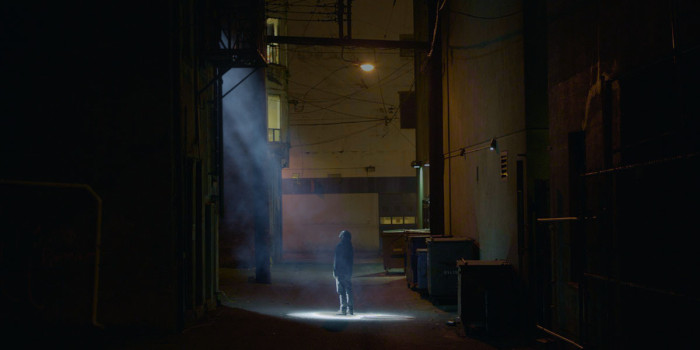This year at the Toronto International Film Festival (TIFF), amidst the star-laden Hollywood premieres and films from 74 countries, two (unsurprisingly Canadian) films debuted that use hockey as a lens to examine larger social issues.

Will Strongheart in Indian Horse. Photo: Postmedia Network
Indian Horse (directed by Stephen Campanelli): The powerful story from wonderful novel (reviewed by Mark Norman here) reaches the screen largely intact. At the premiere, the white producers and director of the film emphasized their adaptation of Wagamese’s work as an act of allyship. While problematic in emphasizing aboriginal representation only in front of the camera as opposed to all facets of production, their respect for the text is evident and thankfully the film does not tone down one of the most intelligent usages of hockey to explore Canadian identity. The film makes one noticeable change to the novel’s story, stretching out the chapter were the protagonist Saul Indian Horse plays Major Junior hockey for the fictional Toronto Monarchs in the 1970s. This sequence rebuts the thesis put forward by Soul on Ice, that the stories of those who “quit” are not worthy of being told like those who make it are. Saul faces racist taunts from the stands, on-ice assault from his opponents, a blind eye from the refs, and bigotry from his own teammates. His coach refuses to listen to Saul’s complaints, telling him that if Reggie Leach could make the NHL, then so can he. This illustrates why just focusing on the successes is so dangerous, it puts the onus on the individual to be resilient through any and all systemic barriers rather than have the sport actually strive towards equity.
The coach also takes Saul to task for his frequent fights, instigated by the rage Saul justly feels at his treatment. The coach’s attitude is the opposite of how many racialized, and indigenous players in particular, who do “make it” are channeled into the enforcer role (for example Stan Jonathan, Ron Delorme, Craig Berube, Gino Odjick, and Chris Simon among many others). As John Valentine (2012) found, from the 1980s (the generation after Saul) to the mid 2000s enforcer decline, indigenous players fought up to seven times more than white players. He suggests that a convergence of four factors created this: the stereotype of indigenous people as “warriors”, a response by players to on-ice racism (Delorme and Odjick stress this), coaches believing this was the appropriate role for indigenous players, and indigenous enforcers being role models for younger players.
While the film is more serious and distant in tone than the novel, lacking Wagamese’s style that makes the reader feel like they’re listening to Saul, it should bring a vital story to a larger audience. The film’s producers talked of their hope this film would be a good educational resource for learning about residential schools. While it does this well, it also is excellent at exposing the lie that Canada wanted assimilation and not genocide of its native population. After all, what’s more Canadian than being a hockey star? Yet Saul still is not welcomed. By capturing all the abuse Saul must work through, the film illustrates how unreasonable it was (and still is) to ask players to, in the hockey cliché, grit it out through oppressive circumstances. This story makes it clear hockey is more often an extension of Canadian racism than a unifying force.
Indian Horse will have a Canadian theatrical run in Spring 2018

Joe Dion Buffalo in Luk’Luk’I. Photo: TIFF
The second film, Luk’Luk’I (the Squamish name for the land Vancouver was built upon), directed by Wayne Wapeemukwa is much more of your “film festival fare”. Wapeemukwa worked with his cast of one professional actor with a disability and four non-professional actors from Vancouver’s Downtown Eastside to craft vignettes about the difficulties of life during the 2010 Vancouver Olympics. The film aims to show us the Canadians who were forgotten about during what was perhaps Canada’s most intense celebration of nationalism. While the wealthy part of the city was partying, less than two kilometres away was one of Canada’s poorest areas.
What is most striking about the film is the impossibility of representing the Olympics, particularly in a negative light. Though billed as a public celebration during the bid, the IOC’s stringent copyright makes their representation nearly impossible to represent in public memory. Extratextually, the film emphasizes how private this supposedly public spectacle really is. Unfortunately, presumably unable to afford the amount of necessary extras, the streets of Vancouver seem eerily empty compared to the party that was going on for those who could afford it.
To their credit, Hockey Canada did lend support to this film – their jersey is prevalent throughout the film, even on characters who sexually harass a protagonist (though everyone is wearing tape over the Nike logo. Copyright is a weird world). They also cleared for the audio broadcast of the Gold Medal game to be used in the film, the only representation of the Games. If you can remember what you were doing during the game, it provides an affecting context for these images of addiction and scraping by. However, without knowing what Vancouver was like during the Olympics to compare to the events going on simultaneously in the film, this critique would lose much of its power.
Luk’Luk’I does not yet have a general release date, but is at many Canadian film festivals
Bonus hockey: Finally, the only other hockey appearance I saw during the festival was in Armando Iannucci’s satire of Soviet party politics, The Death of Stalin. In it, hockey features briefly to the role it often plays in films, as a game of violent chaos (here, of course, mirroring the party politics). However, in addition to seeing Vasily Stalin give a hilarious incompetent attempt at coaching, it references a real forgotten hockey tragedy. In 1950, a plane crash in Sverdlovsk killed the entire Soviet Hockey team, save for three injured players (including the legendary Vsevolod Bobrov, who would go on to coach the Soviet Union in the 1972 Summit Series). Vasily, who was patron of the team, decided to avoid upsetting his father and just replaced the entire team rather than acknowledge the crash. That type of pitch black absurdity sums up the overall film well.
The Death of Stalin will be released theatrically on October 20.
References:
Valentine, J. (2012). New racism and old stereotypes in the National Hockey League: The “Stacking” of Aboriginal Players into the Role of Enforcer. In J. Joseph, S. Darnell, & Y. Nakamura (Eds.), Race and Sport in Canada: Intersecting Inequalities (pp. 107-138). Toronto, ON: Canadian Scholar’s Press.
Advertisements Share this:




